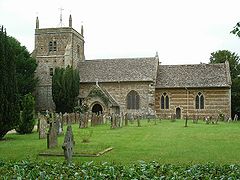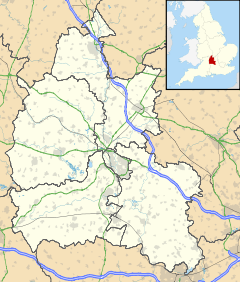- Duns Tew
-
Coordinates: 51°57′14″N 1°20′10″W / 51.954°N 1.336°W
Duns Tew 
St. Mary Magdalene parish church
 Duns Tew shown within Oxfordshire
Duns Tew shown within OxfordshirePopulation 513 (2001 census)[1] OS grid reference SP4528 District Cherwell Shire county Oxfordshire Region South East Country England Sovereign state United Kingdom Post town Bicester Postcode district OX25 Dialling code 01869 Police Thames Valley Fire Oxfordshire Ambulance South Central EU Parliament South East England UK Parliament Banbury List of places: UK • England • Oxfordshire Duns Tew is a village and civil parish about 7.5 miles (12 km) south of Banbury in Oxfordshire. With nearby Great Tew and Little Tew, Duns Tew is one of the three villages known locally as "The Tews".
Contents
Origin of the name
It is thought that "Tew", formerly Teowe or Tiewe (as used in Domesday Book), meant "ridge". Although the village lies on the North Aston Fault, separating limestone and sands in the south from the clay of the north, however, there is no visible sign of any geographoc ridge nearby.
Professor Ekwell has suggested this: “The name TEW is of great antiquity and its roots go back to Anglo-Saxon times. According to Professor Ekwell it probably appeared as Old English word Tiewe, which is known to have existed as an element in compound words (e.g. manigtiewe = skilful). He deduces that Tiewe may have meant a lengthy object, and to have been adopted as the name given to a ridge of land in North West Oxfordshire. In time the name would have been transferred from the feature of the landscape itself to the settlements that became established upon it, and which today are the villages of Great Tew, Little Tew and Duns Tew”.
It is supposed that "Duns" might refer to an Anglo-Saxon person named Dunn, perhaps a landowner, possibly living after the Conquest. The full name of "Duns Tew" does not appear until the 13th century.[2]
Manor
Before the Norman conquest of England, Leofwine of Barton held the manor of Duns Tew along with those of Dunthrop, Little Tew and Westcott Barton.[3]
The Domesday Book of 1086 records four estates in the parish, of which the two largest belonged to Robert D'Oyly and Robert de Stafford.[4] In addition, Gilbert de Magminot, Bishop of Lisieux held an estate of three hides and Odo, Bishop of Bayeux and half-brother of William I held an estate of one hide.[4]
The present manor house contains 17th century remnants and a wing added in the 19th century, but the main part of the present house is 18th century.[5] The house has a 17th century dovecote.[5] Priory Court, a 19th century house east of the church, used to be the vicarage.[6]
Churches
The Church of England parish church of St. Mary Magdalene existed in the 12th century, from which period the font and one lancet window in the chancel survive.[4] The north aisle was added late in the 13th or early in the 14th century.[4] The tower, south porch and many of the present windows were added late in the 14th or early in the 15th century.[4] The tower collapsed in 1647, damaging the south side of the church.[4] It was rebuilt in 1664-65.[4] In 1861-62 Sir George Gilbert Scott completely rebuilt the chancel and north aisle and partly rebuilt the south wall of the nave.[4] The tower has a ring of five bells.[7]
In 1977 the parishes of Duns Tew and Sandford St. Martin were merged with the Benefice of Westcott Barton and Steeple Barton.[4][8]
A Baptist chapel was completed in 1809.[4]
Economic and social history
The parish had a watermill by 1279.[4] It was still recorded in 1618 but seems to have disappeared by 1722.[4]
Most of the parish was farmed under two separate open field systems until 1794, when the common lands were enclosed.[4]
A Sunday School for the parish was founded in 1798 and a day school had been added by 1808.[4] By 1818 the Sunday school had been converted to the National School system.[4] Sir George Dashwood provided and equipped a school building in 1830.[4] The school outgrew its building and in 1874 new premises were completed with capacity for 100 children.[4] In 1928 it was reorganised as a junior school, with senior pupils going to the school at Steeple Aston.[4] The number of pupils declined and in 1969 Duns Tew school was closed.[4] Since 1970 the building has served as Duns Tew village hall.[4]
Amenities
Duns Tew has a public house, the White Horse.[9]
Duns Tew has a Community Action Group.[10]
References
- ^ "Area: Duns Tew CP (Parish): Parish Headcounts". Neighbourhood Statistics. Office for National Statistics. http://neighbourhood.statistics.gov.uk/dissemination/LeadTableView.do?a=7&b=798560&c=Duns+Tew&d=16&e=15&g=480245&i=1001x1003x1004&o=1&m=0&r=1&s=1267998257932&enc=1&dsFamilyId=779. Retrieved 7 March 2010.
- ^ "Duns Tew Tourist Information" by Jon Willian Baxter at aboutbritain.com
- ^ Crossley, 1983, pages 75–81
- ^ a b c d e f g h i j k l m n o p q r s t Crossley, 1983, pages 209–222
- ^ a b Sherwood & Pevsner, 1974, page 590
- ^ Sherwood & Pevsner, 1974, page 591
- ^ Oxford Diocesan Guild of Church Bell Ringers: Banbury Branch: Tower Guide: Duns Tew Oxfordshire
- ^ Archbishops' Council (2010). "Benefice of Westcote Barton with Steeple Barton Duns Tew etc". A Church Near You. Church of England. http://www.achurchnearyou.com/benefice.php?B=27/556BF. Retrieved 11 August 2011.
- ^ The White Horse
- ^ Community Aciton Groups: Oxfordshire: Duns Tew Community Action Group
Sources
- Crossley, Alan (ed.); AP Baggs, Christina Colvin, Howard Colvin (1983). Victoria County History: A History of the County of Oxford, Volume 11. pp. 209–222.
- Sherwood, Jennifer; Pevsner, Nikolaus (1974). The Buildings of England: Oxfordshire. Harmondsworth: Penguin Books. pp. 590–591. ISBN 0 14 071045 0.
External links
- The Duns Tew website on About Britain
- North Oxfordshire Village Trail - Duns Tew page
- Cherwell District Council
- Duns Tew Church and family links
- Family History for Oxfordshire villages
- Early photograph of Duns Tew Manor
- Heavy rainfall over Duns Tew Manor in 1960
- A glimpse of Duns Tew: past and present by Jon Baxter & John Green
Categories:- Villages in Oxfordshire
- Civil parishes in Oxfordshire
Wikimedia Foundation. 2010.




